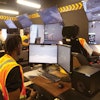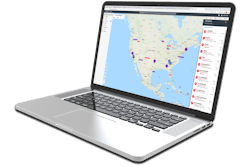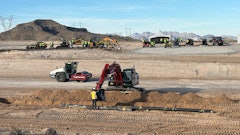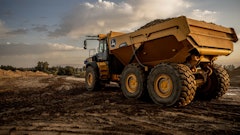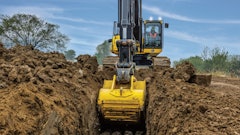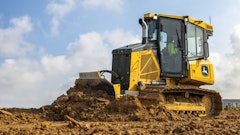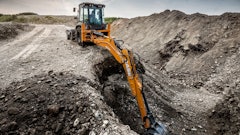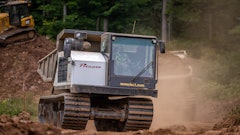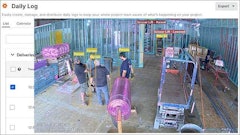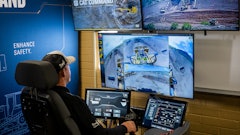
As more owners set sustainability goals for projects, practically approaching jobsite sustainability is becoming essential for contractors who seek to bid on, and win, these contracts. Data that allows companies to monitor and manage their construction equipment operations is key to making practical, cost-effective changes that reduce emissions, curb fossil fuel use and minimize waste. Equipment telematics, used in conjunction with a robust fleet management software platform, provides that data.
Some contractors may be familiar with using the GPS receivers on telematics devices to track the location of their equipment. Sensors on the same telematics devices offer a wealth of additional information, including data on equipment utilization, fuel consumption, engine performance and maintenance needs.
By harnessing the power of telematics, contractors can make data-driven decisions on how best to meet sustainability goals without sacrificing schedules or profits. Some strategies may even benefit the bottom line.
1. Tracking Greenhouse Gas Emissions
Reducing greenhouse gas emissions is typically one of the sustainability goals of project owners. Since most construction equipment runs on petroleum fuel, which generates substantial carbon emissions as well as source pollutants, incorporating lower-emission or zero-emission equipment into a fleet can be essential to meeting emissions goals.
Replacing an entire fleet with alternatively powered equipment, such as battery-electric equipment, isn’t realistic for most jobsites or most companies. Knowing which equipment generates the most emissions allows companies to prioritize fleet changes. With engine hours provided by telematics data, managers can calculate the fuel consumption of a machine, then estimate emissions based on the emissions factor specific to the fuel type used. Some advanced fleet management platforms offer an estimated emissions feature that performs the calculations for customers. In those platforms, users can run reports to estimate metric tons of carbon dioxide equivalent by specific piece of equipment or equipment category class, time period or jobsite. Fleet managers can leverage this visibility to reevaluate equipment with an eye toward cleaner options.
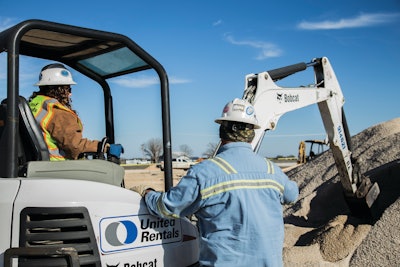 United Rentals
United Rentals
2. Monitoring and Reducing Fuel Consumption
Reducing the amount of fuel consumed by petroleum-fueled equipment is another critical step in controlling emissions. Managers can use data to identify behaviors such as excessive idling and aggressive operation of equipment that result in unnecessary fuel burns. Armed with these insights, they can take steps to address the issues, such as creating and enforcing an anti-idling policy and providing targeted operator training.
Companies can further curb fuel use with the help of equipment access management. Adding radio-frequency identification (RFID) badge readers to ignition locks helps ensure that only authorized workers can operate heavy equipment or turn on fuel-burning equipment such as generators and light towers. Telematics reveals when a machine was started and how long it ran; access management provides the additional detail of who turned it on. Understanding how and when fuel-burning equipment is used and by whom may allow managers to make fuel-saving adjustments to equipment fleets or jobsite operations.
3. Optimizing Equipment Utilization
Keeping track of the equipment on a jobsite and how it is being utilized can be a challenge, but it’s essential to right-sizing fleets. Having more equipment than necessary not only increases costs but also wastes natural resources. Fleet management platforms allow companies to pinpoint the location of each piece of telematics-enabled equipment on a map and see how long it has been there. “Finding” machines that are sitting idle helps companies avoid purchasing or renting additional units. Utilization reports generated in a fleet management platform identify underutilized equipment that could be sent to another jobsite or even sold. If certain units are over-utilized, fleet managers may want to acquire more machines of that type to allow ample time for preventative maintenance.
4. Making Data-Driven Buy vs. Rent Decisions
When additional equipment is needed, utilization data can help companies make informed decisions about whether to purchase new equipment or rent. Often, renting is a more sustainable choice. It supports the sharing economy, which reduces the environmental impact associated with manufacturing new equipment. Machines rented from large, reputable vendors tend to be relatively new and well maintained, which may put it a step ahead of older owned equipment in terms of fuel efficiency and emissions.
Renting also allows companies to use the right equipment for the job so workers can complete tasks as efficiently as possible and without squandering fuel.
5. Monitoring Generator Loads
Contractors typically oversize generators to ensure sufficient energy for peak loads. As a result, generators run underloaded during normal loads and low loads, which wastes a significant amount of fuel. It also causes unnecessary wear and tear on the generators, potentially making them run less efficiently.
When telematics devices are added to generators, managers can track loading in their fleet management platform. Configurable alerts notify them if the load remains too low over an extended period, which is a signal to downsize the generator.
Another solution to generator underloading is pairing the generator with a battery energy storage system (BESS). The generator charges the batteries using surplus power when it runs.
During lower-load periods, the BESS automatically shuts off the generator and provides power on its own. Leveraging a BESS allows for smaller generators and dramatically curtails generator run time, reducing diesel consumption and emissions.
6. Customizing Equipment Maintenance Schedules
Properly maintained equipment runs more smoothly. Regularly tuning up engines, sharpening bucket teeth, checking tire inflation, greasing fittings, cleaning filters and replacing fluids can result in increased fuel efficiency and lower emissions.
Equipment manufacturers typically recommend preventative maintenance at set time intervals, such as six months or 12 months, but equipment may need maintenance more often or less often depending on its utilization.
Over-maintenance wastes machine oil and other resources, while under-maintenance impacts machine performance.
Engine hours provided by telematics enables companies to perform just-in-time maintenance. Certain fleet management platforms support telematics-based service alerts to help keep maintenance on track.
If developing and sustaining a preventative maintenance program proves too arduous, companies can outsource the responsibility to a third-party provider with experience using telematics data to schedule and perform just-in-time maintenance.
Getting Started With Telematics
Many contractors already have access to telematics hardware in one way or another. Equipment manufacturers are including it in most of their latest equipment, though it needs to be activated, which requires a cellular subscription service. In addition, large, reputable rental equipment vendors include telematics devices in a large percentage of their rental fleet.
For companies that own older equipment that is not equipped with telematics, adding aftermarket devices is relatively easy; a rental equipment vendor that offers fleet maintenance can perform the installations.
Unlike most manufacturer-installed devices, these devices work across equipment brands. Brand-agnostic devices that communicate with a centralized fleet management platform solve the issue of relying on manufacturer-specific devices that communicate only with that brand’s software.
Leveraging telematics data to boost productivity and the sustainability of day-to-day operations can help companies be more competitive now and in the future.


